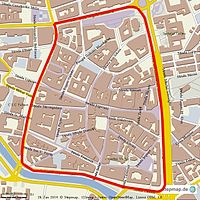Lipscani
|
Lipscani district of Bucharest |
|
|---|---|
| Coordinates | 44 ° 25 '56 " N , 26 ° 6' 1" E |
| Website | www.lipscanibucharest.com |
Lipscani is the name of a neighborhood and a street in the old, historic city center of Bucharest in Romania . Several cities in southern Romania have streets and districts called Lipscani , such as Slatina , Craiova or Ploieşti .
location
The Lipscani district is in the center of the city, north of the Dâmbovița river . Lipscani is located on a small hill, the elevation is particularly evident on the Șelari and Smârdan streets . Officially, the district is located in the 3rd sector of the city, but since Lipscani Street crosses sectors 3, 4 and 5 at the same time, the district also extends into these sectors.
The boundaries of the district are in the west on Calea Victoriei Street , in the north on Bulevardul Regina Elisabeta and Bulevardul Carol I , in the east on Hristo Botev Street and in the south on Unification Square and Bulevardul Corneliu Coposu , Strada Halelor , and Splaiul streets Independenței . Other streets in the neighborhood include Lipscani, Gabroveni , Șelari , and Doamnei (see full list here ). The areas east of Brătianu Street and north of Doamnei Street are often not included in the Lipscani district.
history
In the battles of Mihai Viteazul with the Ottoman army , Grand Vizier Koca Sinan Pasha conquered the city in August 1595 after the battle of Călugăreni , with the district burned down. Viteazul had the district rebuilt on top. The Lipscani district is named after Leipzig ( Lipsca in Romanian ), as traders came from there who sold their goods in the main street. Many professional groups such as goldsmiths, hat makers, shoemakers, dyers and saddlers were represented, with many guilds ( isnafuri ) having their own alley. Even today, some of the streets are named after craft trades, for example arielari = Sattlerstraße.
During the communist era there were plans for the demolition of the district, but these were only partially implemented. Large-scale demolitions of the city center took place after 1940, when a 70-meter-thick lock was pulled through the middle of the city. The IC Bratianu Boulevard was later built there, the main axis of the city today. The city center suffered further damage in the 1977 earthquake . The western side of the district was rebuilt, while almost half of the historical buildings in the east were demolished and the southern side was completely replaced by modern concrete structures.
At the beginning of the 21st century, most of the district was converted into a pedestrian zone. Many gaps in buildings were filled with modern structures. A fact that is now considered inappropriate. The area is a magnet for tourists from all over the world. Today it is mainly residents of the Netherlands and France who come here. Bucharest's nightlife, which is mainly concentrated in the Lipscani area, also attracts younger tourists.
economy
Today the Lipscani district plays a special role in nightlife. More and more restaurants and bars have been opening in the streets since 2008, and since 2013 large department stores such as H&M , Yves Rocher and Adidas . By the beginning of 2013, all streets in the district had been repaved and most of the buildings were renovated.
There are plans to expand the city center, e.g. B. in the direction of Dâmboviţa, along the Calea Victoriei and Boulevard Regina Elisabeta and Carol I .
Important buildings
- The National Art Museum
- The Romanian National Bank
- The Gabroveni Inn
- The Linden Inn
- The comedy theater
- The Lipscanitheater
- The Stavropoleos Monastery
- The Russian Church
- The Zlatari Church
- The Macca-Villacrosse Passages
- The Palace of the Stock Exchange
- The Colțea Hospital
- The Manuc Inn
- The old royal court and its church
- The Roman Catholic Church of Bărăția
- The Cărtureşti Carusel , a former bank building that now houses a bookshop
Picture gallery
The Lindengasthof
The Finance Credit Library on the Smârdan
The Selari Street
The Rome Square in 1927
Buildings on Splaiul Independenței
The old coffee house
Buildings on Strada Soarelui
The Covaci Street
St. Anton-Platz in 1927
Web links
-
 Wikivoyage: Lipscani - Current travel guide to Lipscani
Wikivoyage: Lipscani - Current travel guide to Lipscani
Individual evidence
- ↑ Birgitta Gabriela Hannover: Bucharest: The Romanian Capital and its Surroundings , Trescher Verlag, 2008, ISBN 3-89794-120-1 , page 78ff ( preview in Google book search)
- ^ Constantin C. Giurescu : History of the City of Bucharest (German translation: N. Hochscheidt), Sports and Touristikverlag, Bucharest 1976













